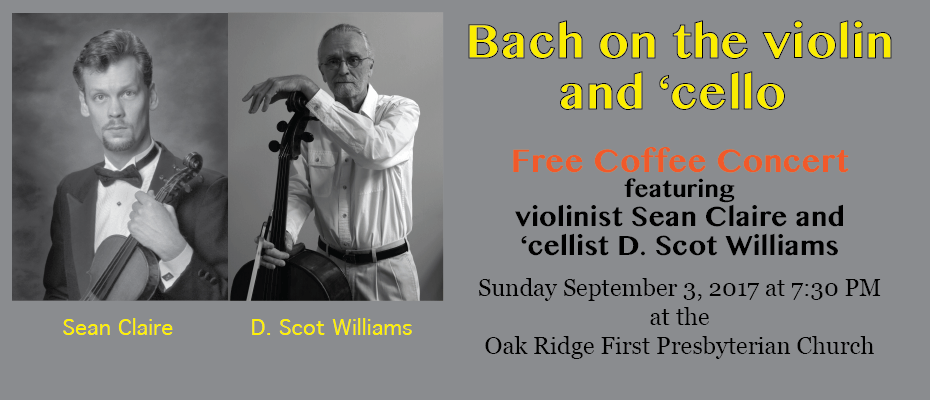Everybody likes free stuff. Everybody likes good stuff. But free and good don’t often happen together, especially when it comes to great music. But Sunday at 7:30 p.m. at Oak Ridge First Presbyterian Church, the Oak Ridge Civic Music Association presents the first of this year’s ORCMA Free Coffee Concerts with an all-Bach program played by Knoxville musicians, violinist Sean Claire and cellist D. Scot Williams. Both are first-rate professional musicians who are long-time members of the Knoxville Symphony and frequently participate in area chamber music concerts. Much of the greatest, most personal, most intimate music, was written to be played in front of small gatherings.
Four of the pieces on the program will feature both Claire and Williams playing “Contrapuntus” numbers XII, XIII, XIV and XV, “Canon at the Octave,” from Bach’s famous collection the “Art of the Fugue.” A canon is a musical form built in a leader and follower format. The first musical line, is repeated by a second melody copying characteristics of the first, but beginning a set number of notes behind and at a different pitch. When the leader and follower in canons are exact copies, it’s a category of canons called rounds.
Additionally, Claire and Williams will each play solo pieces.
Williams’ choice is the most famous of Bach’s solo works for unaccompanied cello, universally known as the Six Cello Suites,”Suite #3 in C Major for solo cello,” BWV 1009. The “BWV” part is the number of the work in the catalogue of Bach’s music. In the classical music world, the catalogue number is the exact identification of the music. In some composers’ catalogues of works there are multiple pieces in the same key, such as Sonata in C major. The only way of knowing which is which is the catalogue number.
“The suite that I knew the most when we decided to do this concert was the #3 in C major,” said Williams, who is also a skilled cabinetmaker in his parallel work life. “Because I’ve played it before, it took less effort and less of my time to get it into performance shape. I absolutely love the improvisation elements in the prelude. It just grabs me.”
Each of the six suites has six sections, or movements, beginning with a prelude, followed by five movements written in the rhythms of popular dance styles of the day, allemande, bourrée, courante, gigue, minuet or sarabande.
The Bach suites were written for himself to play. The first of them may have been written out of boredom during a time when Bach’s employer put him in jail. Since their composition during the period 1717-1723, they were mostly known by a small number of musicians who considered them little more than difficult exercises. Few people even bothered to play them.
All that changed in 1865 when 13-year-old cellist Pablo Casals and his father were rummaging around in bookstores in small Spanish towns looking for music for young Casals to play after his dad had given him his first full-sized cello. Casals made the suites famous. Since then every cellist worth his salt has been judged by how the suites are played.
Claire’s solo piece will be Bach’s “Partita #2 in D minor for solo violin,” BWV 1004, A work that Claire has also played before and wanted the chance to play it again. Partita is just another name for solo instrument, usually a piece with lots of technical demands.
Musicians love the logic of why they are putting the music together on a program. Often it’s pieces collected together with a certain theme, or written during a certain period, or music by all American composers. For this concert, the logic, in addition to everything being written by Bach is the palindromic order of the pieces. Each half of the program begins and ends with a contrapuntus, with a solo piece in the middle, Williams’ suite in the first half, Claire’s partita after the intermission.

